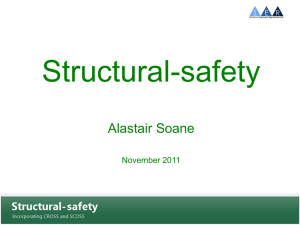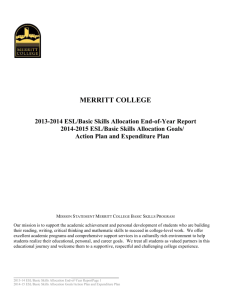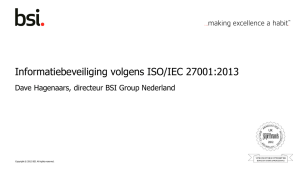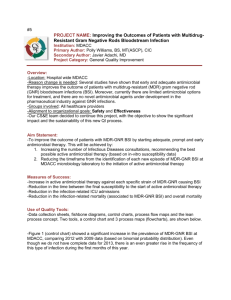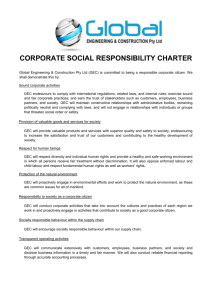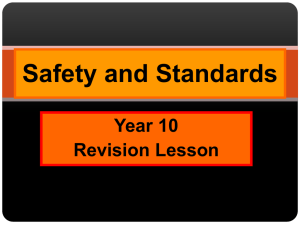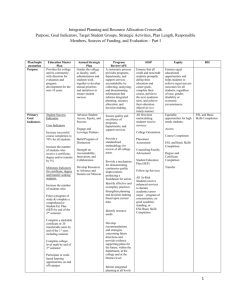Follow Up Questions for GEC Questionnaire BSI August 24, 2012
advertisement
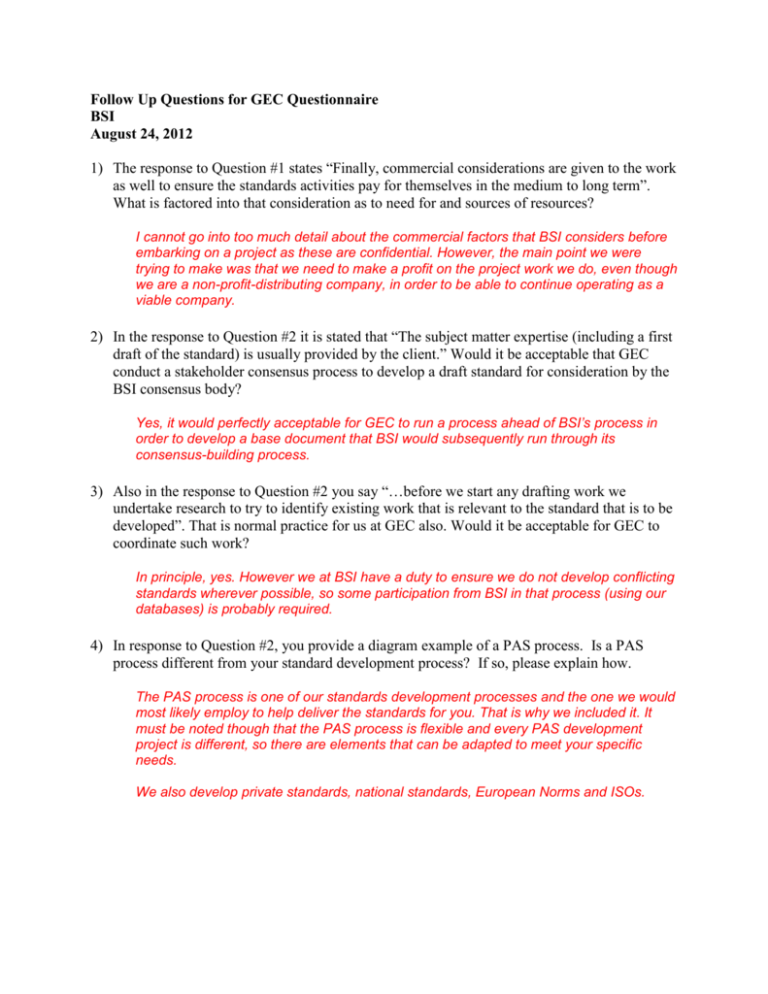
Follow Up Questions for GEC Questionnaire BSI August 24, 2012 1) The response to Question #1 states “Finally, commercial considerations are given to the work as well to ensure the standards activities pay for themselves in the medium to long term”. What is factored into that consideration as to need for and sources of resources? I cannot go into too much detail about the commercial factors that BSI considers before embarking on a project as these are confidential. However, the main point we were trying to make was that we need to make a profit on the project work we do, even though we are a non-profit-distributing company, in order to be able to continue operating as a viable company. 2) In the response to Question #2 it is stated that “The subject matter expertise (including a first draft of the standard) is usually provided by the client.” Would it be acceptable that GEC conduct a stakeholder consensus process to develop a draft standard for consideration by the BSI consensus body? Yes, it would perfectly acceptable for GEC to run a process ahead of BSI’s process in order to develop a base document that BSI would subsequently run through its consensus-building process. 3) Also in the response to Question #2 you say “…before we start any drafting work we undertake research to try to identify existing work that is relevant to the standard that is to be developed”. That is normal practice for us at GEC also. Would it be acceptable for GEC to coordinate such work? In principle, yes. However we at BSI have a duty to ensure we do not develop conflicting standards wherever possible, so some participation from BSI in that process (using our databases) is probably required. 4) In response to Question #2, you provide a diagram example of a PAS process. Is a PAS process different from your standard development process? If so, please explain how. The PAS process is one of our standards development processes and the one we would most likely employ to help deliver the standards for you. That is why we included it. It must be noted though that the PAS process is flexible and every PAS development project is different, so there are elements that can be adapted to meet your specific needs. We also develop private standards, national standards, European Norms and ISOs. 5) In the response to Question #3, you indicate that the Steering Group is “Appointed at the outset of the project, usually limited to 10 to 15 key experts…”, and later in the questionnaire indicate that there is some flexibility about the size of the Steering Group. Given the breadth of stakeholders in our processes, it is likely that a larger Steering Group would be needed. Would BSI consider a Steering Group on the order of 30 to 50 members? We can definitely consider larger Steering Groups and accommodate for that in the process. This will, however, have a cost and delivery timing implication. Therefore we will work together with you to find the right size and balance on the Steering Group. 6) In response to Question #3, in your group process table for Steering Group you state “On the rare occasions when a significant difficulty arises in achieving consensus, processes of mediation and appeal are in place for resolving conflicts”. In our latest standard development process we have observed what are apparently irresolvable conflicts between different stakeholder groups. For example, some stakeholders (a majority many of whom would not accept a standard without such restrictions) wish to restrict the use of certain substances in products that other stakeholders (a significant minority essentially all of whom would not accept a standard with such restrictions) manufacture. How would consensus of the Steering Group, assuming it included both parties, be achieved? Please consider this situation and provide an example. In general terms BSI can be flexible about the decision-making process and how decisions are reached on text that ends up in the final published standard. However, it must remain consistent with the authority and integrity of BSI, which is just as important to you as it is to us because it drives the credibility of the final published standard. That is also why we have several different standards development models. The two most likely to be relevant to GEC are the Private Standard and PAS model. Ultimately, if we (BSI and GEC) are to work with open consensus-based standards it is important to find a balance that works for both of us as well as the wider standards development stakeholder group. You further say in response to Question #7 “…consensus does not imply unanimity”. Presuming that the condition we describe occurs (irresolvable conflict), would it be acceptable to define a specific measured, reliable and predictable process and threshold for achieving consensus? Absolutely! We can come up with a process that is mutually acceptable to both GEC and BSI. And, in response to Question #10 you say “There may be instances where a very influential member (e.g. regulator, government, key industry player) refuses to accept the majority view of the steering group. In those extreme cases BSI has methods to address that type of situation in collaboration with the client.” Please explain more about those “methods”. There are a wide range of techniques and solutions that can be brought to bear, the effectiveness of which greatly depends on the specific conflict situation that is being faced. Some examples include: Take contentious points of discussion off-line. Meet with the stakeholders at polar opposites separately first, then in a three way situation, with the aim to find a middle ground, after which the solution can be presented to the wider stakeholder group. Bring in an independent party, with relevant expertise, to mediate Lift the conversation to a higher level, where the opposing parties do agree, in order to find a solution Remind the opposing parties of the original goal (i.e. to achieve industry-wide consensus) and the ramifications if consensus is not reached Invalidate the viewpoint of one of the opposing parties on grounds that e.g. they do not have the relevant expertise, would not be impacted by the requirements one way or the other, etc. This list is not exhaustive and we can use a wide range of tactics, in collaboration with the GEC. 7) What is the obligation of the Steering Committee to the Review Panel and the comments that they submit? Do all comments require a response and resolution? Yes, all comments have to be addressed by the Steering Group. Once the comments are received, BSI reviews and collates them, grouping together the same/similar comments so that time at Steering Group meetings isn’t wasted. The responses to the comments are not shared back with the Review Panel as a matter of course though. Only when BSI receives a specific request from a Review Panel member about their comments do we send them the responses for their comments (and only their comments, not the comments of others). 8) Regarding the fees that you identify in response to Question #14, would there be possible arrangements such that certain of your services (like research, or possible meeting facilitation, etc.) could be performed by GEC or our contractors and thus reducing the fees? There are some aspects that may be done by GEC rather than BSI. This would need to be discussed further so that we can fully understand a) which parts of the work/process GEC would like to undertake in-house, and b) the capabilities and capacities of GEC to undertake those activities. 9) In Question #16 regarding making standards available, you say that “BSI can also arrange for a distribution license to be drawn up for clients and make it available for free download from the BSI website”. We are interested in the BSI business model and the degree to which a major source of revenue upon which you rely comes from sale of standards and such license agreements. There is obviously only a limited amount of information we can share about this as much of this information is commercially sensitive. In response to Question #23 you state “…the main reason for BSI owning the copyright of the final published standard is because BSI owns the standard on behalf of, and is answerable to, the entire community that the standard has an impact on.” And of course there are the fees for standard development. This may suggest that the sale or license agreement is not primarily an important source of revenue (as it is for some other SDOs), which might make for greater flexibility in such matters. Could you provide some more perspective on your business model as it relates to revenues from standards? For the development of PAS standards the financial model is based on a mix of development fees and sales of the standards post publication. As you rightly indicate the sales of the standard is not the primary source of revenue, however it is part of the model. 10) In Question #18, regarding commercial terms, ANSI and IEEE interpret that to include “business relations” between buyer and seller. For example, IEEE has interpreted that requirements regarding length of product warranty, or a period of time that spare parts must be made available, must not be included in American National Standards. Would these examples violate any BSI policies? These specific principles would not violate any specific BSI policies. Standards we develop are voluntary documents and anybody can decide to use them or not. However, you must be aware that by putting in very specific restrictions as those outlined above may limit the take up of a standard. And it may also be difficult to get consensus within the Steering Group on such types of requirements. Nonetheless, there are no restrictions from BSI’s point of view. 11) In response to Question #24, could you elaborate on the possible situation that completed standards, such as earlier standards in our IEEE 1680 series, could be transferred to BSI in some manner? This depends on what you mean by “transfer to BSI”. We cannot simply take something from IEEE without their permission as they are the copyright holder. It may be possible with their permission, but we’d have to look at a) what the driver/need is for transferring them to BSI and b) what the most effective, inexpensive, robust, and credible method would be to go through with such a transfer. 12) If GEC - which is based in Portland, Oregon and conducts standard meetings primarily in the US - were to enter an arrangement with BSI to develop a BSI environmental assessment standard, how would those organizational relationships work? Would GEC be independent of BSI in conducting meetings, and then submit a draft product for BSI processes? Or could GEC work “on behalf of” BSI in the stakeholder process to develop the draft, also actively engaging Europeans and Asians? Or would all the activities be conducted within BSI with GEC as a participant? Note that currently, the vast majority of our stakeholders are US based. BSI would run the process, but we are more than able to run meetings in the US, Europe or elsewhere. GEC would be a participant. However, as the sponsor of the work would have further controls such as: Working with BSI to determine who the Steering Group members should be Determine where meetings should be held (although this does have a cost implication) Ability to cancel the work at any time Table the first draft of the standard Make strategic decisions about the direction the standard is taking Make decisions on specific content (unless full consensus is reached, which would make this redundant) unless the GEC decision leads to a commercial bias or safety issue 13) Lastly, we would appreciate the opportunity to review your governance document. Does it provide detail on the selection of Steering Group members per your response to Question #8? I have attached a copy of PAS 0, our governance document for PASs. It has some generic information about Steering Group selection in it. And, of course, a PAS may not even be the route that GEC chooses. We can also offer Private Standards and Consortia services.
